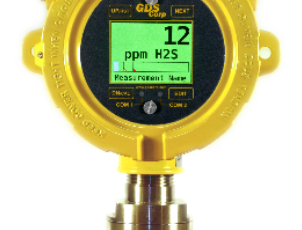There are a wide range of gas sensor products available; which type you use depends on the working environment and what types of gas might be present, such as natural gas, carbon monoxide, or airborne organic compounds. Catalyst sensors are often used to detect hydrocarbons but rely on the presence of oxygen to function.
How do catalyst sensors work
Catalyst sensors have two basic elements: a detector which contains a catalytic material sensitive to flammable gases, and a compensator element which is inert. Combustible gases will burn in the presence of oxygen only on the detector, causing a rise in temperature and a corresponding rise in electrical resistance. The temperature and resistance of the inert compensator remains the same.
A circuit is formed including both elements, and a variable resistor is adjusted to maintain balance in clean air. When combustible gases raise the temperature of the detector and a rise in its resistance, it causes an imbalance in the circuit and produces an output voltage signal. The relative strength of this signal can determine the concentration of flammable gases.
Advantages of catalytic sensors
* Easy to install, use, and calibrate
* Economical, with a long life and low replacement cost.
* Very reliable
* Can be calibrated to gases such as hydrogen which can’t be detected by infrared scanners
* Not sensitive to optics and perform more reliable in dusty environments
* More reliable in high temperature
* Less sensitive to humidity and changes in air
* Detects most hydrocarbon gases
Disadvantages
* Catalyst sensors can become inactive through contamination by chemicals containing chlorine and silicone compounds, as well as sulfuric and other corrosive chemicals.
* The only means of testing sensors is to expose them to known quantities of gas and recalibrate them as needed.
* They require oxygen to operate
* Long exposure to concentrated hydrocarbons may degrade performance.
* If subjected to extreme gas concentration, the sensor may become damaged and show low or no signal
Successful use
* Avoid using silicon sprays or materials near the catalyst sensor, as silicon particles could coat the detector and inhibit it from working properly. Do not pack or store the sensor with silica gels.
* Sensor performance may be degraded by the effect of alkalines such as salts and salt water.
* Organic vapors such as alcohol may permeate and ruin the detector element.
* Water on the catalyst sensor can degrade performance, while ice forming on the sensor in cold environments could damage it.
* The catalyst sensor should be positioned where it won’t be subject to shocks and vibrations that can damage it. Vibration could also cause false readings.
* Sensors that have been stored for a long time should be recalibrated when reconnected.
* If the catalyst sensor is to be repaired, hand-solder without resins, as high temperatures or resin fumes could affect the detector.
In the end, however, a catalytic sensor is a tried and proven technology that works reliably, and over a long period of time. If it is properly installed and maintained, it could save lives.

